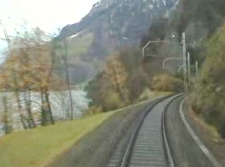Travelling To Lugano
Arriving at Lugano-Agno Airport, Switzerland
Getting to Lugano by plane is extremely easy. The city has its own airport located about 15 minutes (6km) away near the A2 Milan-Basel highway. Lugano-Agno airport is serviced by domestic flights departing from Zurich and Geneva. Flights from Zurich to Lugano take approximately 50 minutes. The two airlines that fly into Lugano are:
- Darwin Airline (Geneva, Rome, Cambridge)
- Swiss International Airlines (Zurich)
The airport has a shuttle bus service that brings passengers into the centre of Lugano. The shuttle runs between 08.00 - 18.30 on weekdays and between 10.00 - 18.30 on weekends, with transfers timed to coincide with flight arrivals. The shuttle drops passengers off at the Swiss Federal Railway Station in the centre of Lugano.
As Lugano-Agno Airport is quite small it means check-in times are relatively quick. If you have return flight from Lugano then it might be useful to know that check-in times normally take about 20 minutes.
Arriving at Malpensa Airport, Milan, Italy
When you arrive at Malpensa Airport (Milan, Italy) you are approximately 80 minutes away from Lugano by road. There is an express bus services connecting Malpensa Airport to Lugano which drops passengers off in the centre by the main station. The buses run regularly (almost hourly) throughout the year. It is always advisable to make an online reservation with the any bus company before your arrival at Malpensa Airport. Shuttle schedules and seat reservations are all available on the Jet Bus website. A return ticket to Lugano costs approximately 50 Euros. An alternative service is the Malpensa Express which makes around 10 return journeys a day from the airport to Lugano and Bellinzona. You can also make seat reservations and see the bus schedule on their website below.
Another option is to catch a train from Milan to Lugano. Trains leaving Milano Central pass through Monza and Como before arriving at Lugano main station. There is often a short delay at the Italian/Swiss border town of Chiasso where passports are checked. The entire journey however still only take around 1.5 hours. An average single ticket costs less than 20 Euros and can be purchased from the SBB Rail site.Travelling to Lugano By Train From Zurich Airport

Another popular option is to fly to Zurich and then continue the journey to Lugano by train. The distance between Lugano and Zurich is about 220 km (137 miles) and should take no longer than 2-3 hours. The journey will take you through some of Switzerland's most breathtaking scenery as it passes through Zug, Arth-Goldau, Gotthard and Bellinzona before arriving in Lugano. The train then continues on to Lake Como before terminating in Milan. Trains bound for Lugano from Zurich are fast, efficient and for most of the time depart almost hourly.
Compared to flying the train journey is worth the extra time it takes as you do get to see some beautiful scenery as you rattle through the Ticino countryside.
Travelling by rail in Switzerland is always a pleasant experience and similar to other modes of public transport it is considered one of the finest in the world. Swiss trains, buses, funiculars, lake steamers and cable cars are clean, efficient and always on time. On the whole the entire public transport system meshes seamleassly together to create one well-oiled machine.
- Swiss Federal Railway - SBB Online
- Rail Service Helpdesk and Timetable 0900 300 300 (CHF 1.19/min.), 24 hrs/day.
Travelling to Lugano by Car from Zurich or Milan
Lugano is also very easy to reach by car as it is situated close to the main A2 motorway that links Northern Europe to Milan and the Mediterranean. If you are approaching Lugano from the Milan direction then you need to follow:
- Autostrada A9 in the direction of Como-San Gottardo and take the exit that is signposted "Lugano SUD"
- Autobahn A2 in the direction of St.Gotthard-Chiasso-Italy and take the exit that is signposted "Lugano NORD"
It's also worth noting that traffic congestion in Lugano is quite bad for a good part of the year which makes driving around the city and parking extremely difficult.
